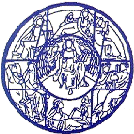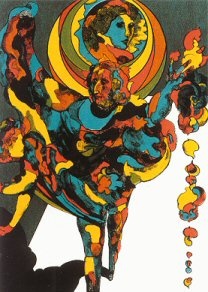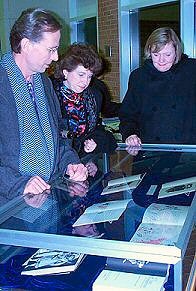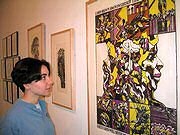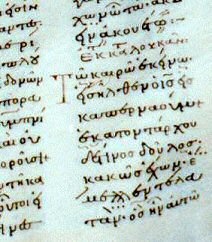Grant Supports Digital Access to Rare LettersMethodist Library Receives ATLA Funds
By Jennifer Woodruff Tait, Methodist Librarian
Drew University is one of seven schools receiving grants from the American Theological Library Association's Cooperative Digital Resources Initiative, Phase Three, for digitization projects. The $5,000 grant will subsidize the digitizing of Drew's extensive collection of letters by John and Charles Wesley and other members of the Wesley family. Digitizing will take place this year, and researchers can access the images starting in 2005 through the ATLA CDRI database at: http://www.atla.com/digitalresources/.
Drew will digitize 175 original manuscript letters of John Wesley, Charles Wesley, and other members of the Wesley family, as well as 60 unpublished hymns by Charles Wesley, several poetical fragments by Charles Wesley, and an unpublished book of poetry by Charles' wife, Sarah Gwynne Wesley, inclusively covering the period 1719-1887.
These additions will complement the Wesley letters digitized by Southern Methodist University in an earlier phase of the project, making available a larger number of Wesley letters and poetic materials which have not been published in a scholarly edition. Some have not been published in any form. The Wesley correspondence and poetry shed light not only on the history and development of Methodism, but also on life in eighteenth- and early nineteenth-century Britain, and will benefit both scholars and religious researchers with interests in Wesley studies and British history. With the support of the Luce Foundation, the ATLA Cooperative Digital Resources Initiative provides a freely available, web-searchable, central repository of digital resources contributed by participating libraries.
CDRI enables member libraries both to create digital resources and to benefit from the digital projects of other libraries. Participating in this round of grants are libraries at Princeton, Vanderbilt, Boston University, Andover Newton, Southern Methodist University, Ohio State, and Southwestern Baptist. They will be digitizing resources as varied as church architecture postcards, woodcuts, missions resources, sermons, and worship services. More details about the schools that participated in Phase One and Two and the resources already available in the CDRI database can be found at http://www.atla.com/cdri/ .
(Some information adapted from the ATLA CDRI website at http://www.atla.com/cdri/.)
[
http://depts.drew.edu/lib/visions/visions15.php#top] |
New Chat Reference Service: Q&A NJ
By Jody L. Caldwell, Head, Reference and Research Services
It's 2:00 a.m. Wednesday, and the deadline for a mid-semester paper is looming. One or two more sources are all you need to underscore your point. Garreted at your desk, you turn to the Library website, and then to Google, but the perfect source eludes your search.
You could really use some help! And now, it's available to Drew University through a leading live Internet chat reference service, Q&A NJ, a state-wide cooperative network of public and academic libraries.
Joining in February 2004, Drew librarians began to help staff the virtual service, answering the questions of New Jersey residents, UMDNJ medical students, college students, and others. As part of the Q&A network, Drew University students can now have those questions answered at 3:00 a.m., be guided to reliable information sources without having to come into the library, and have access to data sources not directly provided by Drew.
The last decades of the twentieth century saw a transformation in the services of libraries around the world. The traditional mission of libraries was, and remains, providing access to the world's knowledge for students and other seekers. But the location and delivery of that knowledge has changed radically, and the academic library now has the opportunity to meet its students and faculties where — and when — they are. Beginning with the improved searching abilities of electronic insdexes within the confines of library buildings, we have been able to move that access to the offices, residence halls, and off-campus housing of our users. Those remotely accessible indexes increasingly provide full text, supplementing the unfiltered environment of the public web with the vetted and verified information sources of academic and professional publishers. While the array of information sources has become increasingly complex, out community is likely to be using those sources in places and at times remote from the helpful hands of librarians.
We've been providing email assistance to users for years, encouraging students to send their questions to reference@drew.edu, and we receive questions daily from visitors to the Library's website. But that necessarily means that our users must wait for a response from us, sometimes past the moment when
they actually need it. The promptness of Q&A's interactive chat service ---and its 24/7 availability — will be an enormous boon to time-crunched students.
We also expect that Q&A NJ will help us reach some students who feel more comfortable in a chat environment. A college library can be intimidating, and many students are reluctant to approach someone in person, but are willing to ask for help in the more anonymous atmosphere of chat reference. And it's not just our students who benefit! The collaboration is providing Drew reference librarians with a stimulating chance to be part of an innovative approach to reference service. Developing new skills that can significantly expand our accessibility is a great opportunity – so we are all gaining from this exciting new service!
To use Q & A NJ, go to the Library's Research Resources at http://depts.drew.edu/lib/research.html and click on Chat and Email Reference Help, http://depts.drew.edu/lib/eref.html. (This service works best with Internet Explorer.)
[
http://depts.drew.edu/lib/visions/visions15.php#top] |
|
THE DIRECTOR'S CORNER:Acts of Acknowledgment |
When you open an academic book for the first time, where do you turn? How do you begin to determine whether it will be useful for your purpose? Assuming that most of us visit the title page as a common port of entry, what is the next stop? The table of contents, the verso of the title page--where the date of publication often hides, submerged in the fine print--preface, first chapter, last chapter, illustrations, dust jacket, or cover blurbs?
I was browsing in the Drew bookstore recently and overheard a student report to a friend that she never purchased a book without reading its final paragraph. My own compass directs me to an adjoining neighborhood at the back of the book, for I rarely buy a volume without first checking out the bibliography or footnotes. The lists of books, journals, and websites that trail the texts of most monographs quickly identify the partners with whom the authors are engaged in conversation. They are also registers of intellectual IOUs, the sources to which the text is indebted in some fashion.
Many authors use an explicit acknowledgment section up front to directly thank the people who played key roles in bringing the project to print. These notes of thanks are as varied as the speeches on Oscar Award Night. Short and long, eloquent and perfunctory, memorable and forgettable, colorful and drab---they name friends, colleagues, institutions, deans, trustees, funding sources, editors, reviewers, research assistants, secretaries, relatives, children, spouses, and the occasional cocker spaniel as integral partners in the publication. Have you noticed that children and spouses tend to bring up the rear of the lists and that the prose droops at best? More than once the thought has crossed my mind that I could build a supplemental income around a service that would provide authors with sprightly words to enliven language for the home front and thereby facilitate a happier re-entry into family life.
But what pleases me most about these acknowledgment sections is that they are there at all. The art of saying "thank you" has waned in many areas of American life (did you write thank you notes for the gifts you received during the recent holidays?), but it remains a fixture of the first pages of academic books. I am struck by how often scholars tip their hats to librarians in their lists of praise. Reference librarians, archivists, and the inter-library loan staff are common heroes. A particularly memorable tribute read, "He seemed to know every book in the stacks and would emerge triumphant with what I needed, much like a hunter from a thicket with a rabbit." And another, "She processed hundreds of requests during my research and never batted an eye."
But as a library director, I am still waiting to present my Oscar to scholars who acknowledge the role of the library as a whole in their books. The librarians and staff at public service counters tend to reap accolades for their work, but those who work behind the scenes do not. Books appear magically on the shelves. Who selects them? Orders them? Unpacks them? Catalogs them? Labels them? Shelves them? Repairs them? Maintains the electronic catalog in which they appear? Pays the invoices? These unseen and unsung heroes are indispensable partners to those who work directly with students, faculty and other scholars. Their work ethic reminds me of Marge Piercy's poem:The people I love the best
jump into work head first
without dallying in the shallows
and swim off with sure strokes almost out of sight.
They seem to become natives of that element,
the black sleek heads of seals
bouncing like half-submerged balls
I love people who harness themselves, an ox to a heavy cart,
who pull like water buffalo, with massive patience,
who strain in the mud and the muck to move things forward,
who do what has to be done, again and again.
Perhaps it is time for me to write a book, just so I might acknowledge those in the library who "move things forward, who do what has to be done, again and again."
— Andrew D. Scrimgeour
References
"To be of use," Good Poems by Garrison Keillor (New York: Penguin, 2002), 157.
[
http://depts.drew.edu/lib/visions/visions15.php#top] |
Recent Gifts to the Library
Professor of French, Emerita, Lucille Becker continues her generous support through the Friends of the Library.
Mrs. Patti Becker has sent a generous gift to the Friends.
The Library acknowledges with thanks a gift from William S. Brockman, G'86.
Mrs. Sarah Chapman sent a welcome gift supporting the Library Book Endowment Fund.
New Jersey historian and Drew alumnus, John Cunningham, donated several photographs and graphic items used in the third edition of his book, University in the Forest (2002).
Dr. Sloane Drayson-Knigge contributed a thoughtful gift in support of the Methodist Collections.
A donation through the Friends of the Library was received from Professor Danna Nolan Fewell.
The Library received with thanks a gift from Mr. Joseph J. Harzbecker, Jr.
Mrs. Dalys Oxnam Jaecker donated a variety of documents from the period of 1961-1974, during which her late husband, Dr. Robert Fisher Oxnam, was president of the University. Among the items was an 1807 ordination certificate for Simon Lucas signed by Francis Asbury, containing the best example in our ordination certificate collection of Francis Asbury's official seal.
The Reverend Barent Johnson has given a generous gift through the Book Endowment Fund.
Mrs. Marilyn S. Linden has contributed as a Friend of the Library, and her gift is received with much appreciation.
Mrs. Lorelei C. P. McConnell has given a kind gift through the Library Friends.
The Library acknowledges with thanks the ongoing support of Mrs. Norma Nudelman.
Mr. and Mrs. Ralph Ocker have sent a much appreciated gift in support of the book endowment.
A generous gift was received from Mr. Kenneth G. Peterson.
The Library gratefully acknowledges the gift of Mrs. Ruby Riemer for the processing of papers from her late husband, Dr. Neal Riemer. At the time of his death in 2001, he was the Andrew V. Stout Professor of Political Philosophy, Emeritus.
Mrs. Hilja Wescott has given a number of books in linguistics, anthropology, and sociology from the library of her late husband, Dr. Roger Wescott, who was Professor of Anthropology and Linguistics, Emeritus.
In Memory of Caroline Coughlin
Dr. Caroline M. Coughlin, who passed away in September, was honored with a thoughtful contribution to the Book Endowment Fund in her memory from Catherine M. Daley.
In Memory of Bernard Samuels
A gift in memory of Bernard Samuels was received through the generosity of children and the kindness of a friend. Juanita Edwards Mercer, wife and mother of Drew alumni, often reads and tells stories to the children in her apartment complex. It is no surprise that these stories sometimes include Drew University. Her storytelling about long-time employee Bernard Samuels inspired the children to contribute their pennies to the library book fund in his memory. Sam, himself, was known for humorous anecdotes and "tales of Drew." The children recently donated $6.37 and plan to continue saving their pennies throughout the year.
Landau "lived life with a sense of exploration" and initiated his creation with a "comprehensive approach" that combined elements of his love of music, art, and literature --- he "never really separated any of them." |
|
Jacob Landau's "Meister Abraham" from the Kingdom of Dreams Suite (1969) |
Landau Brings Color to Drew
By Kathleen Brennan, C'04
Acorn contributing writer
[The following article first appeared in The Acorn, "The Student-Run Newspaper of Drew University," Vol. LXXVI, No. 16, February 13, 2004, and is reprinted here, courtesy of the Acorn editor.]
This past Friday, the Korn Gallery and the University Library inaugurated a retrospective of artist Jacob Landau that will offer the Drew community an opportunity to take in Landau's distinctive lifework until March 5.
Curated by Library Director Andrew Scrimgeour and Landau's friend and representative, Rosa Giletti, in collaboration with Art Professor Raymond Saa Stein, the exhibition is culled from Landau's decades as a renowned illustrator, printmaker and painter, as well as Drew's recently acquired special collection of Landau's archives.
Scrimgeour also drew from his personal relationship with Landau and the show opening's gallery speaker, Dr. David Herrstrom, Scrimgeour's "oldest friend." "[Landau] asked a number of his friends and colleagues to be trustees of a foundation that would ensure his work would be seen in galleries, museums and universities," Scrimgeour said. The library director was happy to oblige. "It made sense that his archives would come to Drew, as he was a New Jersey artist," and Drew prides itself on its tradition of archiving special collections.
Landau's work on display in the library gallery includes book illustrations for more popular novels like the western, River Ranch, a short Christmas story from Good Housekeeping by Billy Graham's wife, and later collaborations with Herrstrom, a poet and accomplished scholar of William Blake. Scrimgeour noted how Landau's earlier illustrations seem to complement the text rather than "move against" it, as in later works.
|
Library friends Dr. David Herrstrom, Constance Herrstrom, and Dorothy Scrimgeour view a selection of books illustrated by the late NJ artist Jacob Landau. |
One of the "most striking" qualities of Landau's images is "the sense that they pull you in and push you out," exuding a "wonderful centripetal force" that magnetically repels the viewer, Herrstrom said. Those images are composed almost exclusively of Landau's favorite repeated subject, the human form. "You do not find scenery in his work," Scrimgeour said. Landau "celebrates humanity by portraying the body in all stages of life, from the innocence of childhood to the devastations of old age and illness," as in works like "Apokalypsis." Sexuality is also "something that [Landau] delights in, but it's not superficial." Like Herrstrom, Scrimgeour stressed that the body is never trite or generic -- it is a particular body that contains the "particularity of a person," a figure recognized for its worth as human, and into which the viewer can project himself to reflect back on one's own conception of personhood.
The idea of mystical vision, particularly that of the prophet, recurs constantly in the exhibition and intertwines with Landau's "relationship to texts." While Herrstrom and Scrimgeour cite Landau's use of color and Michaelangelo-like sense of anatomy as significant elements of the pieces, both seemed to note Landau's use of language and, quite literally, The Word as an essential characteristic. Stained glass windows created for the Knesset Israel temple in Philadelphia, represented in the Korn Gallery in lithograph form, include passages from the prophets they portray, such as Isaiah and Malachi. Several other works are inscribed with Hebrew quotations, as well as Landau's own eloquent musings in English.
|
Junior Anne Percoco views Jacob Landau's "I, John Brown," at the Korn Gallery Exhbit. |
On a perpendicular wall hang striking woodcuts of secular American figures like Mark Twain, Thomas Jefferson and in one of the exhibitions most compelling pieces, "I, John Brown." Like a woodcut of Abraham Lincoln displayed in the library, Mark Twain's image as Samuel Clemens is deeply shaded and accented by "his incubus," as Herrstrom noted.
Landau's "self-identity was as a social critic, and as an artist," Scrimgeour said. "He saw himself in the tradition of the ancient Hebrew prophets, who were [also] social critics ... in the more profound sense of a prophet who speaks for God, speaking truth about what is happening then and there in the culture." As Landau "portrays the prophets" and individualists that populate his luminous drawings, prints, and paintings, "he does the work of a prophet with his pens and ink."
" He had to show his life as he saw it in the most truthful way he knew," Scrimgeour said, reflecting a quote from Landau's Artist's Statement 2001. In works as complex and diverse as "Holocaust," "The Mark of Cain," "The Question," "Modern Prometheus," the exhibition's namesake, "Kingdom of Dreams Suite," and Scrimgeour's own "St. Jude Window Cartoon for a Stained Glass Window," Landau's work strikingly and beautifully reveals the truths he contained.
http://depts.drew.edu/lib/visions/visions15.php#top
Migration to New Software for Technical Applications
By Lessie Culmer-Nier, Head, Cataloging and Periodicals
After fifteen years with the same library automation software and an aging computer, Drew Library has migrated to Unicorn, a system owned by the Sirsi Corporation. Unicorn features web-based modules housed on a new computer which is compatible with the Drew network. The migration process took eight months, culminating January 6, when we cut over to our new system.
Although we are all excited by the possibilities which the new system promises, we are in a period of adjustment. The software stores and manipulates our complex catalog and patron information in ways that are different from the former DRA system. Thus every keystroke and procedure that librarians and staff have used for the past fifteen years has been affected, particularly in behind-the-scenes operations such as acquisitions, cataloging and periodicals.
Circulation policies have not changed significantly. However, reports and procedures in this area have changed and may affect users initially as we learn and adjust. Users will be most aware of our migration when using the public catalog. The software which runs the public catalog looks quite different from our old system's catalog, and we continue to refine its display and functionality.
*We want to Hear from You!*Drew University Library has a brand new suggestion box in the main lobby for your comments and suggestions. Check the bulletin board for the latest comments and responses; use the form provided to offer your own ideas. |
From the Special CollectionsVisiting Researcher Studies Greek Manuscripts at Drew
By Lucy Marks, Methodist Cataloger
Every research library has its hidden treasures, rare or unique materials that are largely unknown to the public and often unfamiliar even to the library staff, due to the arcane or recondite nature of these works. When an expert finally unlocks the key to their meaning, both the library and the scholarly world at large benefit.
Such was the case recently when Dr. Nadezhda Kavrus-Hoffman, a Russian-born specialist in Byzantine manuscripts, spent five days at the Drew library examining our collection of eight Greek manuscripts.
|
One of eight Byzantine manuscripts on parchment in the University Library recently studied by visiting specialist, Dr. Nadezhda Kavrus-Hoffman as part of her research efforts to create a national catalog of Byzantine materials. |
Dr. Kavrus-Hoffman is Project Director of the "Catalogue of Greek Manuscripts in the Collections of the USA," an effort to examine and fully describe the complete Greek manuscript holdings in libraries nationwide. Supported by grants from Dumbarton Oaks Research Center for Byzantine Studies, the Houghton Library at Harvard University, and the Bibliographical Society of America, Dr. Kavrus-Hoffman has cataloged the Greek manuscripts at Columbia University, Dumbarton Oaks, Harvard, the Pierpont Morgan Library, the Walters Art Museum, and now Drew University, with several institutions still to be visited. Her goal is to produce two catalog entries for each manuscript: a short electronic version for the Columbia-sponsored web site "Digital Scriptorium," and a full version for publication. The latter will be produced in collaboration with a specialist in Byzantine textology, a Byzantine musicologist, and an art historian.
Dr. Kavrus-Hoffman considers the collection of Greek manuscripts at Drew to be "interesting and important for scholars of the New Testament." Of the eight manuscripts, four are lectionaries of the Gospels, one is an incomplete copy of the Gospels, one is the Epistles of Paul, and two are fragments with texts that are still to be identified. Dr. Kavrus-Hoffman analyzed and determined such details as writing style, writing material, decoration, and watermarks. In the course of her work, she was also able to correct the dates that had originally been attributed to the manuscripts in a 1937 census. For example, lectionaries previously thought to date to the fourteenth century were in fact from the eleventh century. She considers the Pauline Epistles, written by Joasaph, a famous fourteenth century scribe and monk from a prominent monastery in Constantinople, to be the most interesting manuscript. This is because of the "puzzle" of why Joasaph included two dates in his colophon--1366 and 1369--instead of the customary single date. "A slight difference in script and ink indicates, perhaps, an interval of three years…which is highly unusual and needs some explanation."
In an attempt to solve this puzzle and to review and verify her other findings, Dr. Kavrus-Hoffman will return to Drew in the fall, and perhaps also give a public lecture on Drew's Greek manuscripts. Thanks to her expertise, these "hidden treasures" have been rediscovered and revealed.
Library Exhibits
Main Library
March 15 – May 7, 2004
Bela Kornitzer's Great American Heritage: A Journalist and Five Presidents
A selection from the Bela Kornitzer Collection curated by the Library's Special Collections and Archives Committee.
May 8-13, 2004
The 1936 Olympics in Context: A Collection from the Center for Holocaust/Genocide Study
Professor Elfriede Smith and students from her seminar in Advanced German, display volumes and translations related to the 1936 Olympics. The materials on view are a gift to the Center for Holocaust and Genocide Studies from Andrew Liput, Esq., C'84.
May 14 - June 30, 2004
Belgium: Photographs by Horst Staudner, C'88
Exhibit sponsored by the Office of Alumni/ae Affairs in conjunction with
the College's reunion weekend.
Methodist Archives Center
February 27-August 31, 2004
"I Received My Commission from Him, Brother": Woman Preachers in the Methodist and Holiness Traditions.
The exhibit features the life stories and writings of fourteen women who were leaders and preachers in various branches of Methodism--and its more radical offshoot, the Holiness movement--and will be on display through the summer of 2004.
The story of women preachers in Methodism began in the 1700s with John Wesley's followers Sarah Crosby, Hester Rogers, and Mary Bosanquet Fletcher. All conducted public ministry, and Crosby and Fletcher were crucial in convincing Wesley to sanction women's preaching, arguing that some women had an "extraordinary call" to this vocation.
About Visions
VISIONS
NEWSLETTER OF THE DREW UNIVERSITY LIBRARY
Dr. Andrew D. Scrimgeour, Director
Drew University Library, Madison, NJ 07940
(973) 408-3322 ascrimge@drew.edu
EDITOR: Anna S. Magnell
PHOTOGRAPHS: Drew University Archives, A. Magnell, A. Scrimgeour
THIS ON-LINE EDITION: Anne L. Noss
A complete online archive of past issues of Visions
can be viewed at:https://uknow.drew.edu/confluence/display/Library/Visions+Library+Newsletter+Archive
VISIONS is a semi-annual publication.
© Drew University Library

